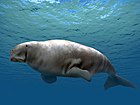
Manatees are large, fully aquatic, mostly herbivorous marine mammals sometimes known as sea cows. There are three accepted living species of Trichechidae, representing three of the four living species in the order Sirenia: the Amazonian manatee, the West Indian manatee, and the West African manatee. They measure up to 4.0 metres long, weigh as much as 590 kilograms (1,300 lb), and have paddle-like tails.

The Sirenia, commonly referred to as sea cows or sirenians, are an order of fully aquatic, herbivorous mammals that inhabit swamps, rivers, estuaries, marine wetlands, and coastal marine waters. The extant Sirenia comprise two distinct families: Dugongidae and Trichechidae with a total of four species. The Protosirenidae and Prorastomidae families are extinct. Sirenians are classified in the clade Paenungulata, alongside the elephants and the hyraxes, and evolved in the Eocene 50 million years ago (mya). The Dugongidae diverged from the Trichechidae in the late Eocene or early Oligocene.

The Amazonian manatee is a species of manatee that lives in the Amazon Basin in Brazil, Peru, Colombia and Ecuador. It has thin, wrinkled brownish or gray colored skin, with fine hairs scattered over its body and a white chest patch. It is the smallest of the three extant species of manatee.

The African manatee, also known as the West African manatee, is a species of manatee that inhabits much of the western region of Africa – from Senegal to Angola. It is the only manatee species to be found in the Old World.

The West Indian manatee, also known as the North American manatee, is a large, aquatic mammal native to warm coastal areas of the Caribbean, from the eastern US to northern Brazil. Living alone or in herds, it feeds on underwater plants and uses its whiskers to navigate. It is divided into two endangered subspecies, the Florida manatee in the US and the Antillean manatee in the Caribbean, both of which face pressure from habitat loss, pollution, and other human activity. The West Indian manatee is the largest living member of the sirenians, a group of large aquatic mammals that includes the dugong, other manatees, and the extinct Steller's sea cow.

Sirenia is the order of placental mammals which comprises modern "sea cows" and their extinct relatives. They are the only extant herbivorous marine mammals and the only group of herbivorous mammals to have become completely aquatic. Sirenians are thought to have a 50-million-year-old fossil record. They attained modest diversity during the Oligocene and Miocene, but have since declined as a result of climatic cooling, oceanographic changes, and human interference. Two genera and four species are extant: Trichechus, which includes the three species of manatee that live along the Atlantic coasts and in rivers and coastlines of the Americas and western Africa, and Dugong, which is found in the Indian and Pacific oceans.
A manatee is a large, fully aquatic marine mammal sometimes known as the "sea cow".
The dwarf manatee is a disputed species of manatee allegedly found in the freshwater habitats of the Amazon, though restricted to one tributary of the Aripuanã River. According to Marc van Roosmalen, the scientist who proposed it as a new species, it lives in shallow, fast-running water, and feeds on different species of aquatic plants from the Amazonian manatee, which prefers deeper, slower-moving waters and the plants found there. The dwarf manatee reportedly migrates upriver during the rainy season when the river floods to the headwaters and shallow ponds. Based on its small range, the dwarf manatee is suggested to be considered critically endangered if indeed a separate species, but is not recognized by the IUCN.
Ribodon is an extinct genus of manatee that lived around South America during the Tortonian. The type species is R. limbatus.

Miosiren is an extinct genus of manatee from the Early Miocene of southeastern England (Suffolk) and Antwerp, Belgium.

Trichechus hesperamazonicus, the western Amazonian manatee, is an extinct species of manatee that lived about 40 thousand years ago in the Madeira River, in the Brazilian state of Rondonia. It is known from this single locality, with possible occurrences in the Brazilian state of Acre.









